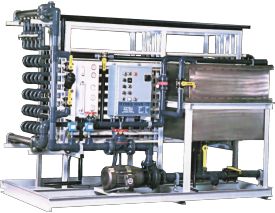Ultrafiltration (UF) is meant to remove high-molecular weight substances such as colloidal materials, and organic and inorganic polymeric molecules including bacteria, and most viruses. Ultrafiltration uses pressure to separate the particulates from the liquid. Low applied pressures are sufficient to achieve high flux rates from an ultrafiltration membrane.

Ultrafiltration uses a cross-flow separation process. The feed stream flows tangentially across the membrane surface, the permeate flows out of the stream while the concentrate will get progressively more concentrated as the permeate is removed. The Membrane does not collect particles, it acts as a barrier allowing clean permeate to penetrate and the feed flow to concentrate. The pore sizes for ultrafiltration membranes range between 0.001 and 0.1 micron.
Met-Chem, Inc.
837 East 79th St.
Cleveland, OH 44103
Phone: (216) 881-7900
Email: info@metchem.com
Copyright © Met-Chem, Inc